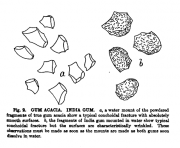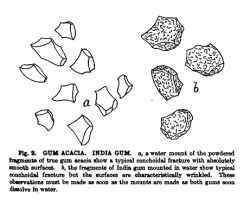Acacia senegal (gum)
m |
|||
| Line 9: | Line 9: | ||
=Botanical Voucher Specimen= | =Botanical Voucher Specimen= | ||
=Organoleptic Characteristics= | =Organoleptic Characteristics= | ||
| + | {{Macroscopy | source=Schneider, A. (1921) The Microanalysis of Powdered Vegetable Drugs, 2nd ed. | ||
| + | | description=''Acacia senecal'' dried brittle glassy gummy exudation. AKA Gum Arabic. | ||
| + | | texture=A meal. Should not be lumpy or in sticky masses. | ||
| + | | color=White to nearly snow white. | ||
| + | | flavor=Mucilaginous taste, sticky. | ||
| + | | scent=Nearly odorless.}} | ||
| + | |||
=Macroscopic Characteristics= | =Macroscopic Characteristics= | ||
{{Macroscopy | source=United States Dispensatory (1918) | {{Macroscopy | source=United States Dispensatory (1918) | ||
| Line 19: | Line 26: | ||
=Microscopic Characteristics= | =Microscopic Characteristics= | ||
| + | {| border=1 | ||
| + | | | ||
{{Microscopy | source=Schneider, A. (1921) The Microanalysis of Powdered Vegetable Drugs, 2nd ed. | {{Microscopy | source=Schneider, A. (1921) The Microanalysis of Powdered Vegetable Drugs, 2nd ed. | ||
| mainimage=Microanalysis_powdered_vegetable_p_202_google_ver_acacia.png | | mainimage=Microanalysis_powdered_vegetable_p_202_google_ver_acacia.png | ||
| Line 30: | Line 39: | ||
| adulterants=India gum is the most common adulterant of gum acacia. Old gum acacia turns yellowish amber color and increases in brittleness. The impurities are generally negligable and should not exceed 1 per cent. | | adulterants=India gum is the most common adulterant of gum acacia. Old gum acacia turns yellowish amber color and increases in brittleness. The impurities are generally negligable and should not exceed 1 per cent. | ||
| }} | | }} | ||
| + | |||
| + | {{Media |cat=Microscopy | ||
| + | | source=Schneider, A. (1921) The Microanalysis of Powdered Vegetable Drugs, 2nd ed. | ||
| + | | mainimage=Microanalysis_powdered_vegetable_p_202_google_ver_acacia.png }} | ||
| + | |} | ||
=High Performance Thin Layer Chromatographic Identification= | =High Performance Thin Layer Chromatographic Identification= | ||
=Supplementary Information= | =Supplementary Information= | ||
=Sources= | =Sources= | ||
<references /> | <references /> | ||
Revision as of 00:21, 16 March 2014
Contents |
Nomenclature
Acacia senegal (L.) Willd. Fabaceae
Standardized common name (English): gum arabic tree
Botanical Voucher Specimen
Organoleptic Characteristics
|
Macroscopic Characteristics
|
Microscopic Characteristics
|

